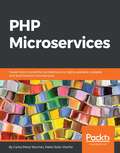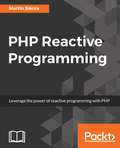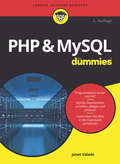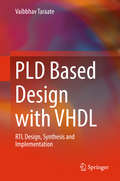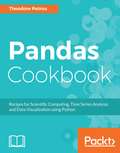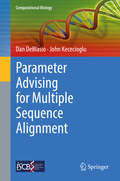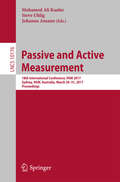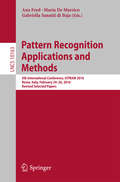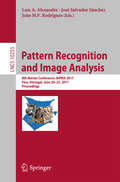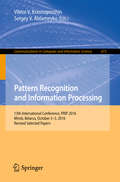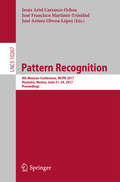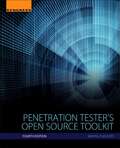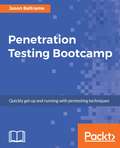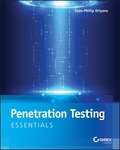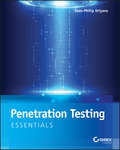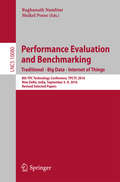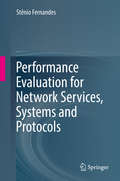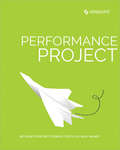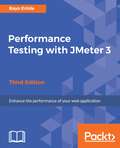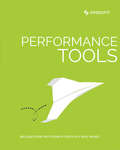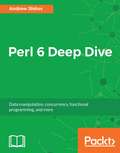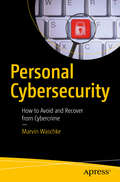- Table View
- List View
PHP Microservices
by Carlos Perez Sanchez Pablo Solar VilarinoTransit from monolithic architectures to highly available, scalable, and fault-tolerant microservices About This Book • Build your own applications based on event-driven microservices and set them up on a production server. • Successfully transform any monolithic application into a microservice. • Monitor the health of your application, prevent downtime, and reduce costs. Who This Book Is For PHP developers who want to build scalable, highly available, and secure applications will find this book useful. No knowledge of microservices is assumed. What You Will Learn • Set up a development environment using the right strategies and tools. • Learn about application design and structure to start implementing your application. • Transform a monolithic application into microservices. • Explore the best way to start implementing your application using testing. • Understand how to monitor your microservices, handle errors, and debug the application. • Deploy your finished application into a production environment and learn how to solve common problems. • Know how to scale your application based on microservices once it is up–and-running. In Detail The world is moving away from bulky, unreliable, and high-maintenance PHP applications, to small, easy-to-maintain and highly available microservices and the pressing need is for PHP developers to understand the criticalities in building effective microservices that scale at large. This book will be a reliable resource, and one that will help you to develop your skills and teach you techniques for building reliable microservices in PHP. The book begins with an introduction to the world of microservices, and quickly shows you how to set up a development environment and build a basic platform using Docker and Vagrant. You will then get into the different design aspects to be considered while building microservices in your favorite framework and you will explore topics such as testing, securing, and deploying microservices. You will also understand how to migrate a monolithic application to the microservice architecture while keeping scalability and best practices in mind. Furthermore you will get into a few important DevOps techniques that will help you progress on to more complex domains such as native cloud development, as well as some interesting design patterns. By the end of this book you will be able to develop applications based on microservices in an organized and efficient way. You will also gain the knowledge to transform any monolithic applications into microservices. Style and approach Filled with code that you can start typing straightaway, this book will take you through building, testing, securing, and deploying microservices in the most practical way possible. The focus of the book is more inclined towards showing you how it's done, rather than with what to do, although you will get a good idea of those tools most widely used to build microservices.
PHP Reactive Programming
by Martin SikoraLeverage the power of Reactive Programming in PHP About This Book • Develop an interesting multiplayer browser game written in RxJS and re-implement it using RxPHP • Enhance existing reactive applications by building a CLI tool combining Symfony Console • Implement Gearman and Rabbit MQ for asynchronous communication Who This Book Is For This book is aimed at people with a solid knowledge of PHP and programming languages in general. We also assume they have at least a little experience with other technologies such as JavaScript, Node.js, and others. What You Will Learn • How to work with the RxPHP library and see what it offers via many examples • Use the RxPHP library in combination with Symfony Console • The different approaches to using Symfony3's Event Dispatcher component • Test your reactive PHP code using PHPUnit • Analyze PHP source code and apply a custom set of rules by building a CLI tool In Detail Reactive Programming helps us write code that is concise, clear, and readable. Combining the power of reactive programming and PHP, one of the most widely used languages, will enable you to create web applications more pragmatically. PHP Reactive Programming will teach you the benefits of reactive programming via real-world examples with a hands-on approach. You will create multiple projects showing RxPHP in action alone and in combination with other libraries. The book starts with a brief introduction to reactive programming, clearly explaining the importance of building reactive applications. You will use the RxPHP library, built a reddit CLI using it, and also re-implement the Symfony3 Event Dispatcher with RxPHP. You will learn how to test your RxPHP code by writing unit tests. Moving on to more interesting aspects, you will implement a web socket backend by developing a browser game. You will learn to implement quite complex reactive systems while avoiding pitfalls such as circular dependencies by moving the RxJS logic from the frontend to the backend. The book will then focus on writing extendable RxPHP code by developing a code testing tool and also cover Using RxPHP on both the server and client side of the application. With a concluding chapter on reactive programming practices in other languages, this book will serve as a complete guide for you to start writing reactive applications in PHP. Style and approach This book will teach readers how to build reactive applications in a step-by-step manner. It will also present several examples of reactive applications implemented with different frameworks.
PHP and MySQL für Dummies (Für Dummies)
by Janet ValadePHP ist nach wie vor die wichtigste serverseitige Websprache und MySQL das wichtigste Webdatenbank-Managementsystem. Als Team sind die beiden unschlagbar, wenn es um die Erstellung dynamischer Webseiten geht. In diesem Buch erklärt Ihnen Janet Valade die Grundlagen und das Zusammenspiel von PHP und MySQL anhand typischer Anwendungsbeispiele.
PICTURING QUANTUM PROCESSES: A First Course in Quantum Theory and Diagrammatic Reasoning
by Bob Coecke Aleks KissingerThe unique features of the quantum world are explained in this book through the language of diagrams, setting out an innovative visual method for presenting complex theories. Requiring only basic mathematical literacy, this book employs a unique formalism that builds an intuitive understanding of quantum features while eliminating the need for complex calculations. This entirely diagrammatic presentation of quantum theory represents the culmination of ten years of research, uniting classical techniques in linear algebra and Hilbert spaces with cutting-edge developments in quantum computation and foundations. Written in an entertaining and user-friendly style and including more than one hundred exercises, this book is an ideal first course in quantum theory, foundations, and computation for students from undergraduate to PhD level, as well as an opportunity for researchers from a broad range of fields, from physics to biology, linguistics, and cognitive science, to discover a new set of tools for studying processes and interaction.
PLD Based Design with VHDL
by Vaibbhav TaraateThis book covers basic fundamentals of logic design and advanced RTL design concepts using VHDL. The book is organized to describe both simple and complex RTL design scenarios using VHDL. It gives practical information on the issues in ASIC prototyping using FPGAs, design challenges and how to overcome practical issues and concerns. It describes how to write an efficient RTL code using VHDL and how to improve the design performance. The design guidelines by using VHDL are also explained with the practical examples in this book. The book also covers the ALTERA and XILINX FPGA architecture and the design flow for the PLDs. The contents of this book will be useful to students, researchers, and professionals working in hardware design and optimization. The book can also be used as a text for graduate and professional development courses.
POKéMON GO COME RISPARMIARE SULLA BATTERIA +8 CONSIGLI E TRUCCHI CHE DEVI LEGGERE
by Game Guidez Vincenzo LantinoPosso insegnarvi a RADDOPPIARE la vita della vostra batteria o anche di più! Nella nostra guida ci dedichiamo subito ai consigli ed ai trucchetti che vi aiuteranno ad allungare la vita della vostra batteria nel minor tempo possibile. Vi guidiamo passo-passo con alcuni dei trucchi più ambiti che abbiamo scoperto sul risparmio della vostra preziosa batteria. Se volete divertirvi di più, MOLTO DI PIÙ, questo è il libro che fa per voi! Tratteremo vari argomenti come: il drenaggio della batteria ad opera del sonoro, applicazioni in background, come raddoppiare instantaneamente la durata della vostra batteria, diminuire il consumo di batteria passo-passo, opzioni avanzate del bluetooth, manipolazione del piano dei dati d'internet, opzioni magiche del gioco e giocare a basso costo energetico. Se non avete voglia di leggere fandonie e volete andare al sodo, questo è il miglior libro che potreste desiderare! Prendete oggi la vostra copia e diventate il maestro di Pokémon che sapete di essere!
Pandas Cookbook
by Ted PetrouThis book is for Python developers who wish to perform data analysis and scientific computing with Python. Those who wish to implement data analysis in Python will need to use Pandas at one point or another—and this book will come very handy. Examples are suitable for both novice and advanced users, as they cover a variety of real-world problem data sets.
Pantsuit Nation
by Libby ChamberlainAn inspiring collection of stories and photographs that capture what it means to live, work, love, and resist in America—from the Facebook group with millions of engaged and impassioned members. In October 2016, Maine resident Libby Chamberlain created a “secret” Facebook group encouraging a handful of friends to wear pantsuits to the polls. Overnight, the group of thirty exploded to 24,000 members. By November 8, the group was three million strong. Since Pantsuit Nation’s inception, its members have shared personal stories that illustrate the complexities of living in a vibrant, oftentimes contentious democracy. Members turn to Pantsuit Nation as a place of refuge and inspiration, where marginalized voices are amplified, faces are put to political decisions, resources are shared, and activism is ignited. It is a dynamic, diverse community united by an unwavering commitment to building a more just, inclusive world. Now, hundreds of Pantsuit Nation members have contributed their stories and photographs to form this extraordinary book. An indelible testament to the idea that change comes first from the heart, and that the surest way to move a heart is to tell a story, Pantsuit Nation is a portrait of a moment in history and a rallying cry for our time.
Parameter Advising for Multiple Sequence Alignment
by Dan DeBlasio John KececiogluThis book develops a new approach called parameter advising for finding a parameter setting for a sequence aligner that yields a quality alignment of a given set of input sequences. In this framework, a parameter advisor is a procedure that automatically chooses a parameter setting for the input, and has two main ingredients: (a) the set of parameter choices considered by the advisor, and (b) an estimator of alignment accuracy used to rank alignments produced by the aligner. On coupling a parameter advisor with an aligner, once the advisor is trained in a learning phase, the user simply inputs sequences to align, and receives an output alignment from the aligner, where the advisor has automatically selected the parameter setting. The chapters first lay out the foundations of parameter advising, and then cover applications and extensions of advising. The content * examines formulations of parameter advising and their computational complexity, * develops methods for learning good accuracy estimators, * presents approximation algorithms for finding good sets of parameter choices, and * assesses software implementations of advising that perform well on real biological data. Also explored are applications of parameter advising to * adaptive local realignment, where advising is performed on local regions of the sequences to automatically adapt to varying mutation rates, and * ensemble alignment, where advising is applied to an ensemble of aligners to effectively yield a new aligner of higher quality than the individual aligners in the ensemble. The book concludes by offering future directions in advising research.
Passive and Active Measurement: 18th International Conference, PAM 2017, Sydney, NSW, Australia, March 30-31, 2017, Proceedings (Lecture Notes in Computer Science #10176)
by Mohamed Ali Kaafar, Steve Uhlig and Johanna AmannThis book constitutes the proceedings of the 18th International Conference on Passive and Active Measurement, PAM 2017, held in Sydney, Australia, in March 2017.The 20 full papers presented in this volume were carefully reviewed and selected from 87 submissions. They are organized in topical sections on IPv6, Web and applications, security, performance, latency, characterization and troubleshooting, and wireless.
Pattern Recognition Applications and Methods: 5th International Conference, ICPRAM 2016, Rome, Italy, February 24-26, 2016, Revised Selected Papers (Lecture Notes in Computer Science #10163)
by Ana Fred, Maria Marsico and Gabriella Sanniti di BajaThis book contains revised and extended versions of selected papers from the 5th International Conference on Pattern Recognition, ICPRAM 2016, held in Rome, Italy, in February 2016.The 13 full papers were carefully reviewed and selected from 125 initial submissions and describe up-to-date applications of pattern recognition techniques to real-world problems, interdisciplinary research, experimental and/or theoretical studies yielding new insights that advance pattern recognition methods.
Pattern Recognition and Image Analysis
by Luís A. Alexandre José Salvador Sánchez João M. RodriguesThis book constitutes the refereed proceedings of the 8th Iberian Conference on Pattern Recognition and Image Analysis, IbPRIA 2017, held in Faro, Portugal, in June 2017. The 60 regular papers presented in this volume were carefully reviewed and selected from 86 submissions. They are organized in topical sections named: Pattern Recognition and Machine Learning; Computer Vision; Image and Signal Processing; Medical Image; and Applications.
Pattern Recognition and Information Processing
by Viktor V. Krasnoproshin Sergey V. AblameykoThis book constitutes the refereed proceedings of the 13th International Conference on Pattern Recognition and Information Processing, PRIP 2016, held in Minsk, Belarus, in October 2016. The 18 revised full papers presented were carefully reviewed and selected from 72 submissions. The papers are organized in topical sections on summarizing lectures; pattern recognition and image analysis; information processing and applications.
Pattern Recognition: 9th Mexican Conference, MCPR 2017, Huatulco, Mexico, June 21-24, 2017, Proceedings (Lecture Notes in Computer Science #10267)
by Jesús Ariel Carrasco-Ochoa, José Francisco Martínez-Trinidad and José Arturo Olvera-LópezThis book constitutes the refereed proceedings of the 9th Mexican Conference on Pattern Recognition, MCPR 2017, held in Huatulco, Mexico, in June 2017. The 29 revised full papers presented were carefully reviewed and selected from 55 submissions. The papers are organized in topical sections on pattern recognition and artificial intelligence techniques, image processing and analysis, robotics and remote sensing, natural language processing and recognition, applications of pattern recognition.
Penetration Tester's Open Source Toolkit
by Jeremy Faircloth<p>Continuing a tradition of excellent training on open source tools, Penetration Tester’s Open Source Toolkit, Fourth Edition is a great reference to the open source tools available today and teaches you how to use them by demonstrating them in real-world examples. This book expands upon existing documentation so that a professional can get the most accurate and in-depth test results possible. Real-life scenarios are a major focus so that the reader knows which tool to use and how to use it for a variety of situations. This updated edition covers the latest technologies and attack vectors, including industry specific case studies and complete laboratory setup. <p>Great commercial penetration testing tools can be very expensive and sometimes hard to use or of questionable accuracy. This book helps solve both of these problems. The open source, no-cost penetration testing tools presented work as well or better than commercial tools and can be modified by the user for each situation if needed. Many tools, even ones that cost thousands of dollars, do not come with any type of instruction on how and in which situations the penetration tester can best use them. Penetration Tester's Open Source Toolkil, Fourth Edition bridges this gap providing the critical information that you need.</p>
Penetration Testing Bootcamp
by Jason BeltrameSharpen your pentesting skill in a bootcamp About This Book • Get practical demonstrations with in-depth explanations of complex security-related problems • Familiarize yourself with the most common web vulnerabilities • Get step-by-step guidance on managing testing results and reporting Who This Book Is For This book is for IT security enthusiasts and administrators who want to understand penetration testing quickly. What You Will Learn • Perform different attacks such as MiTM, and bypassing SSL encryption • Crack passwords and wireless network keys with brute-forcing and wordlists • Test web applications for vulnerabilities • Use the Metasploit Framework to launch exploits and write your own Metasploit modules • Recover lost files, investigate successful hacks, and discover hidden data • Write organized and effective penetration testing reports In Detail Penetration Testing Bootcamp delivers practical, learning modules in manageable chunks. Each chapter is delivered in a day, and each day builds your competency in Penetration Testing. This book will begin by taking you through the basics and show you how to set up and maintain the C&C Server. You will also understand how to scan for vulnerabilities and Metasploit, learn how to setup connectivity to a C&C server and maintain that connectivity for your intelligence gathering as well as offsite processing. Using TCPDump filters, you will gain understanding of the sniffing and spoofing traffic. This book will also teach you the importance of clearing up the tracks you leave behind after the penetration test and will show you how to build a report from all the data obtained from the penetration test. In totality, this book will equip you with instructions through rigorous tasks, practical callouts, and assignments to reinforce your understanding of penetration testing. Style and approach This book is delivered in the form of a 10-day boot camp style book. The day-by-day approach will help you get to know everything about penetration testing, from the use of network reconnaissance tools, to the writing of custom zero-day buffer overflow exploits.
Penetration Testing Essentials
by Sean-Philip OriyanoPenetration Testing Essentials provides a starting place for professionals and beginners looking to learn more about penetration testing for cybersecurity. Certification eligibility requires work experience—but before you get that experience, you need a basic understanding of the technical and behavioral ways attackers compromise security, and the tools and techniques you'll use to discover the weak spots before others do. You'll learn information gathering techniques, scanning and enumeration, how to target wireless networks, and much more as you build your pen tester skill set. You'll learn how to break in, look around, get out, and cover your tracks, all without ever being noticed. Pen testers are tremendously important to data security, so they need to be sharp and well-versed in technique, but they also need to work smarter than the average hacker. This book set you on the right path, with expert instruction from a veteran IT security expert with multiple security certifications. IT Security certifications have stringent requirements and demand a complex body of knowledge. This book lays the groundwork for any IT professional hoping to move into a cybersecurity career by developing a robust pen tester skill set.
Penetration Testing Essentials
by Sean-Philip OriyanoYour pen testing career begins here, with a solid foundation in essential skills and concepts Penetration Testing Essentials provides a starting place for professionals and beginners looking to learn more about penetration testing for cybersecurity. Certification eligibility requires work experience—but before you get that experience, you need a basic understanding of the technical and behavioral ways attackers compromise security, and the tools and techniques you'll use to discover the weak spots before others do. You'll learn information gathering techniques, scanning and enumeration, how to target wireless networks, and much more as you build your pen tester skill set. You'll learn how to break in, look around, get out, and cover your tracks, all without ever being noticed. Pen testers are tremendously important to data security, so they need to be sharp and well-versed in technique, but they also need to work smarter than the average hacker. This book set you on the right path, with expert instruction from a veteran IT security expert with multiple security certifications. IT Security certifications have stringent requirements and demand a complex body of knowledge. This book lays the groundwork for any IT professional hoping to move into a cybersecurity career by developing a robust pen tester skill set. Learn the fundamentals of security and cryptography Master breaking, entering, and maintaining access to a system Escape and evade detection while covering your tracks Build your pen testing lab and the essential toolbox Start developing the tools and mindset you need to become experienced in pen testing today.
Performance Evaluation and Benchmarking. Traditional - Big Data - Internet of Things
by Meikel Poess Raghunath NambiarThis book constitutes the thoroughly refereed post-conference proceedings of the 8th TPC Technology Conference, on Performance Evaluation and Benchmarking, TPCTC 2016, held in conjunction with the 41st International Conference on Very Large Databases (VLDB 2016) in New Delhi, India, in September 2016. The 9 papers presented were carefully reviewed and selected from 20 submissions. They reflect the rapid pace at which industry experts and researchers develop innovative techniques for evaluation, measurement and characterization of complex systems.
Performance Evaluation for Network Services, Systems and Protocols
by Stênio FernandesThis book provides a comprehensive view of the methods and approaches for performance evaluation of computer networks. It offers a clear and logical introduction to the topic, covering both fundamental concepts and practical aspects. It enables the reader to answer a series of questions regarding performance evaluation in modern computer networking scenarios, such as ‘What, where, and when to measure?’, ‘Which time scale is more appropriate for a particular measurement and analysis?’, 'Experimentation, simulation or emulation? Why?’, and ‘How do I best design a sound performance evaluation plan?’. The book includes concrete examples and applications in the important aspects of experimentation, simulation and emulation, and analytical modeling, with strong support from the scientific literature. It enables the identification of common shortcomings and highlights where students, researchers, and engineers should focus to conduct sound performance evaluation. This book is a useful guide to advanced undergraduates and graduate students, network engineers, and researchers who plan and design proper performance evaluation of computer networks and services. Previous knowledge of computer networks concepts, mechanisms, and protocols is assumed. Although the book provides a quick review on applied statistics in computer networking, familiarity with basic statistics is an asset. It is suitable for advanced courses on computer networking as well as for more specific courses as a secondary textbook.
Performance Project
by Bruno Skvorc Claudio Ribeiro Tonino Jankov Zoran AntolovicPerformance simply matters. Technology may allow us to "go bigger", but maybe not necessarily be better when it comes to performance. Now is the time to utilize the amazing tools that are available for making websites faster, and to learn how to improve user experience and satisfaction. This book contains a series of practical, real-world performance tutorials, all based around a single project: a simple image gallery blog. We'll build the project, and then run through a series of performance optimization processes; by the time we're done, we'll have achieved very significant performance improvements. This book is packed with useful, real world hints and tips that you can use on your sites today. It contains: Building an Image Gallery Blog with Symfony Flex: the Setup by Zoran AntolovicBuilding an Image Gallery Blog with Symfony Flex: Data Testing by Zoran AntolovicPHP-level Performance Optimization with Blackfire by Bruno SkvorcMySQL Performance Boosting with Indexes and Explain by Claudio RibeiroImproving Performance Perception with Pingdom and GTmetrix by Tonino JankovImproving Performance Perception: On-demand Image Resizing by Bruno SkvorcUsing Background Processing to Speed Up Page Load Times by Bruno SkvorcServer-side Optimization with Nginx and pm-static by Tonino JankovHow to Use Varnish and Cloudflare for Maximum Caching by Bruno Skvorc This book is for all developers who wish to build sites and apps that run faster. It covers a range of performace tools; familiarity with web development is assumed.
Performance Testing with JMeter 3 - Third Edition
by Bayo ErinleA practical guide to help you undertand the ability of Apache jMeter to load and performance test various server types in a more efficient way. About This Book • Use jMeter to create and run tests to improve the performance of your webpages and applications • Learn to build a test plan for your websites and analyze the results • Unleash the power of various features and changes introduced in Apache jMeter 3.0 Who This Book Is For This book is for software professionals who want to understand and improve the performance of their applications with Apache jMeter. What You Will Learn • See why performance testing is necessary and learn how to set up JMeter • Record and test with JMeter • Handle various form inputs in JMeter and parse results during testing • Manage user sessions in web applications in the context of a JMeter test • Monitor JMeter results in real time • Perform distributed testing with JMeter • Get acquainted with helpful tips and best practices for working with JMeter In Detail JMeter is a Java application designed to load and test performance for web application. JMeter extends to improve the functioning of various other static and dynamic resources. This book is a great starting point to learn about JMeter. It covers the new features introduced with JMeter 3 and enables you to dive deep into the new techniques needed for measuring your website performance. The book starts with the basics of performance testing and guides you through recording your first test scenario, before diving deeper into JMeter. You will also learn how to configure JMeter and browsers to help record test plans. Moving on, you will learn how to capture form submission in JMeter, dive into managing sessions with JMeter and see how to leverage some of the components provided by JMeter to handle web application HTTP sessions. You will also learn how JMeter can help monitor tests in real-time. Further, you will go in depth into distributed testing and see how to leverage the capabilities of JMeter to accomplish this. You will get acquainted with some tips and best practices with regard to performance testing. By the end of the book, you will have learned how to take full advantage of the real power behind Apache JMeter. Style and approach The book is a practical guide starting with introducing the readers to the importance of automated testing. It will then be a beginner's journey from getting introduced to Apache jMeter to an in-detail discussion of more advanced features and possibilities with it.
Performance Tools
by Ahmed Bouchefra Tonino Jankov Hayden James Zoran AntolovicPerformance simply matters. Technology may allow us to "go bigger", but maybe not necessarily be better when it comes to performance. Now is the time to utilize the amazing tools that are available for making websites faster, and to learn how to improve user experience and satisfaction. This is a practical collection of tutorials on some of the most popular and powerful website performance tools available. It's packed with useful, real world hints and tips that you can use on your sites today. It contains: 23 Development Tools for Boosting Website Performance by Ahmed BouchefraImproving Page Load Performance: Pingdom, YSlow and GTmetrix by Tonino JankovPHP-FPM Tuning: Using pm static for Max Performance by Hayden JamesOptimization Auditing: A Deep Dive into Chrome's Dev Console by Ahmed BouchefraPerformance Auditing: A Firefox Developer Tools Deep Dive by Ahmed BouchefraWeb App Performance Testing with Siege: Plan, Test, Learn by Zoran Antolovic This book is for all developers whio wish to build sites and apps that run faster. It covers a range of performance tools; some familiarity with web performance terms and techniques is assumed.
Perl 6 Deep Dive
by Andrew ShitovLearn Perl 6 effortlessly to solve everyday problems About This Book • Filled with practical examples, this comprehensive guide explores all aspects of Perl 6. • Leverage the power of Perl 6 concurrency to develop responsive and high-performant software. • Delves into various programming paradigms (such as Object Oriented, functional, and reactive) that can be adopted by Perl 6 developers to write effective code. Who This Book Is For This book is for developers who would like to learn the Perl programming language. A basic knowledge of programming is assumed. What You Will Learn • Learn the background from which Perl 6 appeared and how it developed. • How to use Rakudo to run your programs. • Various Perl 6 built-in types and details about their behavior • Understand how scalar variables, hash variables, and arrays work • Create meta operators and hyper operators • How classes work and how to build software based on the Object Oriented Paradigm • How Perl 6 provides support for concurrency, functional programming, and reactive programming. In Detail Perl is a family of high-level, general-purpose, interpreted, dynamic programming languages consisting of Perl 5 and Perl 6. Perl 6 helps developers write concise and declarative code that is easy to maintain. This book is an end-to-end guide that will help non-Perl developers get to grips with the language and use it to solve real-world problems. Beginning with a brief introduction to Perl 6, the first module in the book will teach you how to write and execute basic programs. The second module delves into language constructs, where you will learn about the built-in data types, variables, operators, modules, subroutines, and so on available in Perl 6. Here the book also delves deeply into data manipulation (for example, strings and text files) and you will learn how to create safe and correct Perl 6 modules. You will learn to create software in Perl by following the Object Oriented Paradigm. The final module explains in detail the incredible concurrency support provided by Perl 6. Here you will also learn about regexes, functional programming, and reactive programming in Perl 6. By the end of the book, with the help of a number of examples that you can follow and immediately run, modify, and use in practice, you will be fully conversant with the benefits of Perl 6. Style and approach This book will take you through essential Perl 6 concepts so you can implement them immediately
Personal Cybersecurity
by Marvin WaschkeDiscover the most prevalent cyber threats against individual users of all kinds of computing devices. This book teaches you the defensive best practices and state-of-the-art tools available to you to repel each kind of threat. Personal Cybersecurity addresses the needs of individual users at work and at home. This book covers personal cybersecurity for all modes of personal computing whether on consumer-acquired or company-issued devices: desktop PCs, laptops, mobile devices, smart TVs, WiFi and Bluetooth peripherals, and IoT objects embedded with network-connected sensors. In all these modes, the frequency, intensity, and sophistication of cyberattacks that put individual users at risk are increasing in step with accelerating mutation rates of malware and cybercriminal delivery systems. Traditional anti-virus software and personal firewalls no longer suffice to guarantee personal security. Users who neglect to learn and adopt the new ways of protecting themselves in their work and private environments put themselves, their associates, and their companies at risk of inconvenience, violation, reputational damage, data corruption, data theft, system degradation, system destruction, financial harm, and criminal disaster. This book shows what actions to take to limit the harm and recover from the damage. Instead of laying down a code of "thou shalt not" rules that admit of too many exceptions and contingencies to be of much practical use, cloud expert Marvin Waschke equips you with the battlefield intelligence, strategic understanding, survival training, and proven tools you need to intelligently assess the security threats in your environment and most effectively secure yourself from attacks. Through instructive examples and scenarios, the author shows you how to adapt and apply best practices to your own particular circumstances, how to automate and routinize your personal cybersecurity, how to recognize security breaches and act swiftly to seal them, and how to recover losses and restore functionality when attacks succeed. What You'll Learn Discover how computer security works and what it can protect us from See how a typical hacker attack works Evaluate computer security threats to the individual user and corporate systems Identify the critical vulnerabilities of a computer connected to the Internet Manage your computer to reduce vulnerabilities to yourself and your employer Discover how the adoption of newer forms of biometric authentication affects you Stop your router and other online devices from being co-opted into disruptive denial of service attacks Who This Book Is For Proficient and technically knowledgeable computer users who are anxious about cybercrime and want to understand the technology behind both attack and defense but do not want to go so far as to become security experts. Some of this audience will be purely home users, but many will be executives, technical managers, developers, and members of IT departments who need to adopt personal practices for their own safety and the protection of corporate systems. Many will want to impart good cybersecurity practices to their colleagues. IT departments tasked with indoctrinating their users with good safety practices may use the book as training material.
